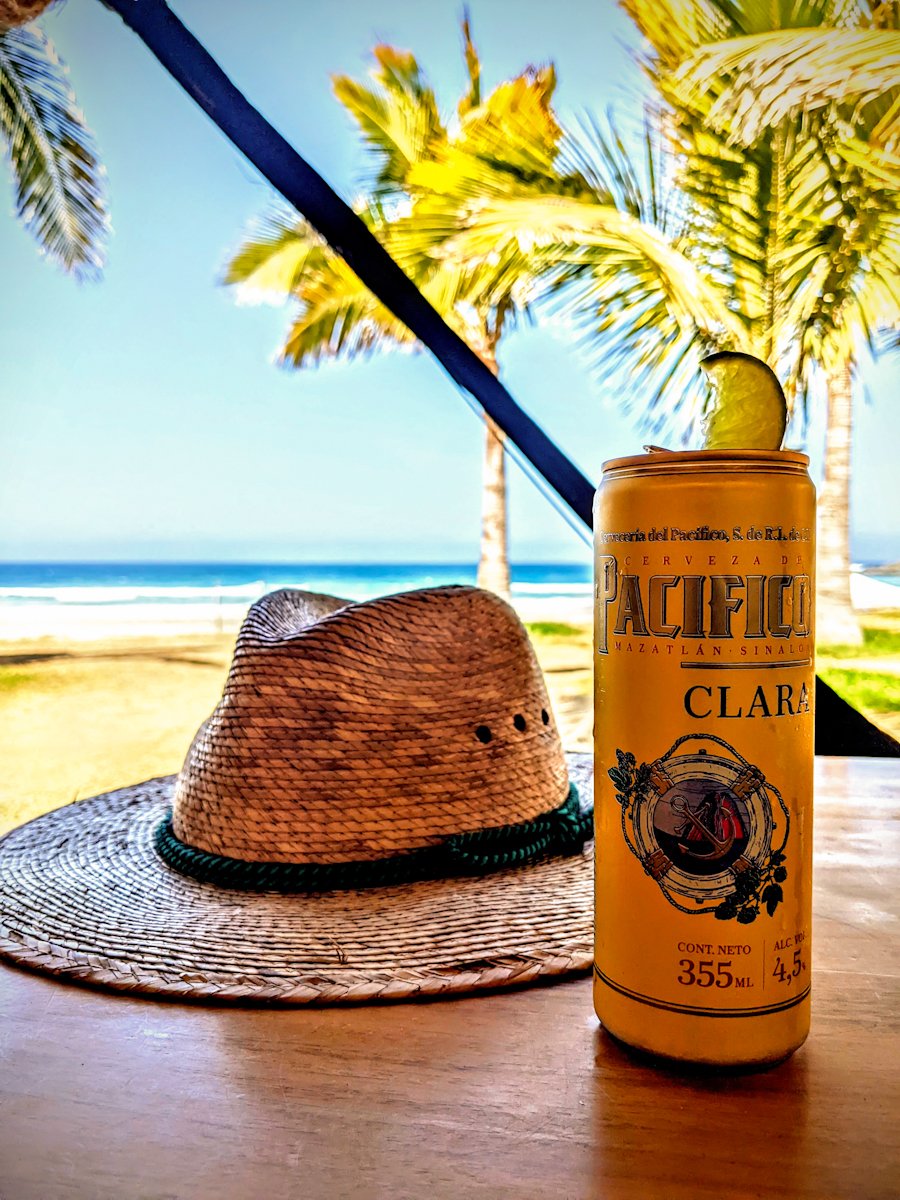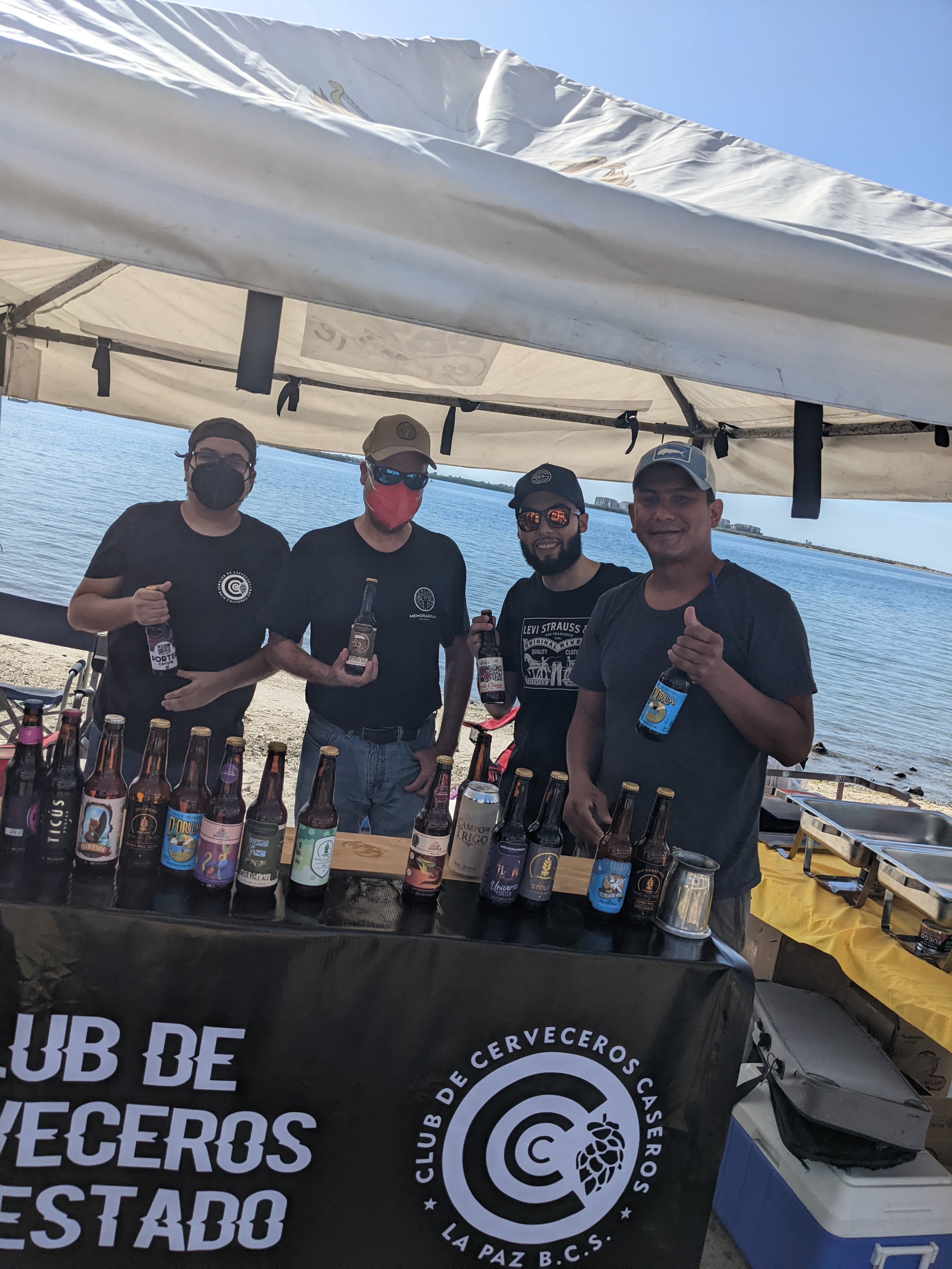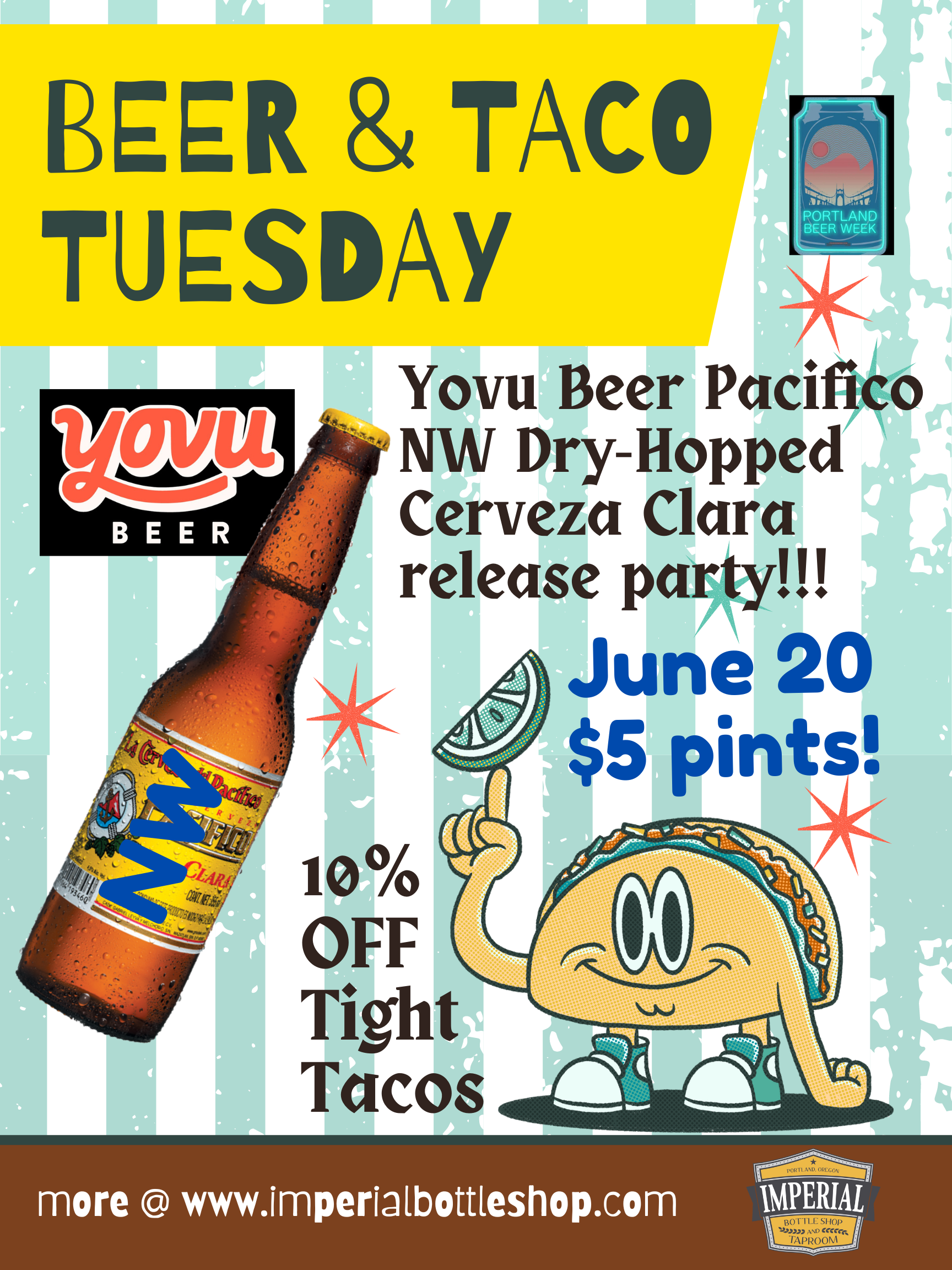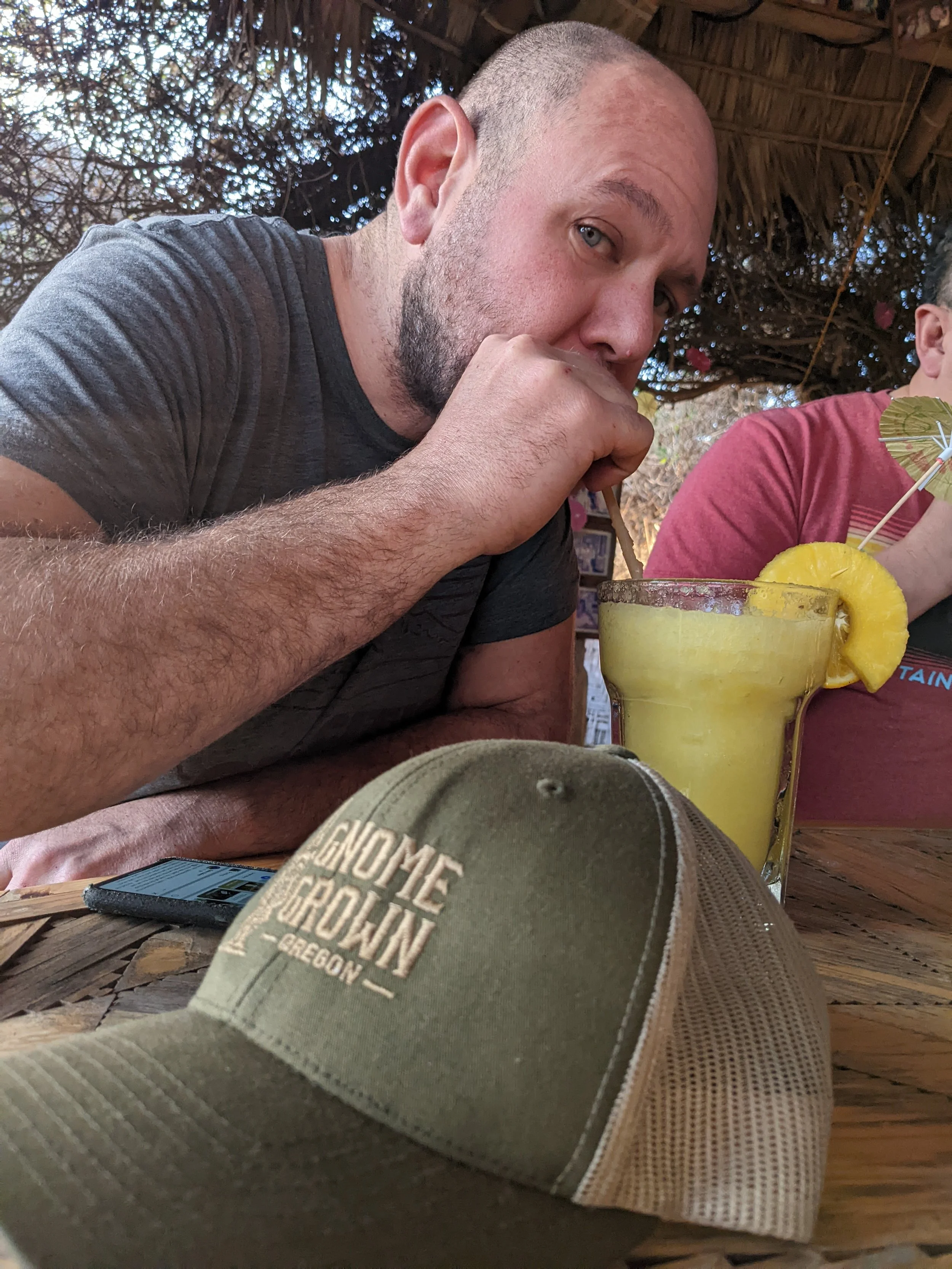How Pacifico Saved My Love for Beer
Confessions of a beer bar/bottleshop owner: How Pacifico Saved My Love for Beer - by Alex Kurnellas
In 2022, my wife and I closed our second location of Imperial Bottle Shop & Taproom. To say the least, that was an emotionally complex experience for me. I don’t really take failure so well, but after a few months, my therapist convinced me to not take it so personally.
After all, two of the biggest contributors to that bar’s closure were completely out of my control: 1) my wife was diagnosed with cancer shortly after we opened, and 2) right after she recovered, the pandemic started. I was proud of us for surviving through those 5 years, and I could see that closing our second bar was a huge weight off my shoulders and opened up other opportunities for me. However, something continued to weigh heavy on my heart…
I didn’t love craft beer anymore. And it wasn’t me. Oh no, it was you, craft beer. You changed. You were like that local band that goes big, and then all your new fans and new songs suck. You were no longer special. The passion was gone, and I knew in my heart we had to break up.
Deep down I was heartbroken and confused. For 10 years, I had built a career and business around craft beer. If we broke up, what would happen to our first location of Imperial? And what would I do? Would I start all over again? At 44 years old, that was a bit scary. Would I call up my ex job? Would I find a new gig??? I had never tried online job-searching before. What was the job pool even like these days for a middle-aged man? Weren’t all the good jobs already taken, and aren’t employers googly-eyed for the youngins? I really had no idea what I would do, but I knew I was done with craft beer. My job had become just work and no fun, and that was the reason I left my writing career to open up a beer bar.
To be honest, it wasn’t just craft beer that got to me. I was over working in the service industry and with the general public. I was also tired of the social and political climate in America. I was exhausted in so many ways, and knew I didn’t really have it in me to jump right into a new career. I decided to take some time off to do a little soul-searching, and ran away to La Paz, Mexico for a month.
I had been to La Paz before. It’s the capital of South Baja, a few hours north of Cabo on the east coast of the peninsula. And I knew it would be perfect: a short cheap flight away; inexpensive nice lodging; amazing dry, warm, sunny weather and beautiful beaches; killer food scene with fish tacos all day, fresh seafood at night, hamburguesas, hot dogs, and tacos al pastor sliced from a trompo late night; Uber and all the modern amenities I needed; and most importantly, far enough away from Cabo that there were very few Americans and little to no craft beer. I imagined myself drinking frozen margaritas and pina coladas during the day, and at night sipping mezcal and swilling cheap Mexican beer in bars where I couldn’t understand a single conversation. My Spanglish was just good enough to say what I needed to, but not good enough to understand a damn thing, which was perfect for an undercover introvert like myself. I went to La Paz (“The Peace” in Spanish) thinking it would be a place so separated from my life that I could let go of my past and find a new path for the future. I never thought that I’d rekindle my love for beer, which is exactly what happened.
My studio cabana had a view of the bay, a pool, and came with a cat that left me dead birds as presents, all for just $19/night! Sleeping under that thatch roof in a noisy city was certainly interesting though.
Week 1 in MX… I drank my fair share of margaritas, pina coladas, and daiquiris.
Mezcal was the local spirit of choice, and I frequented a mezcal bar in town. I had a fun (and intense) conversation with the bartender about terrior, and discovered the local version of the carajillo, with mezcal, which I loved.
It happened about 2 weeks into my trip there. My cabana had a thatch roof and typically stayed cool with a breeze off the bay. But it had no AC, and that day was going to be in the high 90s with little breeze. I decided to get out of the city early in the day when it was still cool, and biked up the coast a few miles to a little beach where I could spend the day in the shade and water.
By the time I set off biking that morning, the sun was already sweltering hot, and I was a sweaty mess by the time I arrived at the beach. I rented an umbrella, table and chair and a waiter gave me a menu for the little bar & grill there. I was hot and urgently thirsty, so before the waiter could walk away, I just quickly skimmed the menu and ordered the first thing that looked refreshing. I looked right past the sugary frozen drinks I had drank too much of the day before, and zeroed in on one item… a cubeta (bucket) of 10 Pacificos for $10. OK, so maybe casually ordering yourself 10 beers before noon is a bit much, but I was thirsty, ice cold Pacifico sounded perfectly refreshing, and it was only $10. Plus, I didn’t HAVE to drink them all.
When the waiter dropped off my cubeta, he pulled a bottle from the ice, cracked it open with the opener tied to the bucket, and handed it to me. My fingers fumbled into a plastic baggy and pulled out a tiny lime slice, which I shoved down the long neck of the bottle. I flipped the bottle over on my lips, and as the ice cold beer filled my mouth, flowed down my throat, and a little trickled over my chin, I was more present in the moment than I had been in a long long time. I was tasting that Pacifico in a more honest and appreciative way than I had the thousands of craft beers I had tried before it. In fact, that Pacifico gave me a bit of deja vu for the very first craft beer that I had. That was a warm Sam Adams Boston Lager in a garage in Texas in March 1994. The slightly roasty malt with notes of bread & toffee was complemented by a touch of earthy hops, and I instantly realized that beer was so much more than the watery pale yellow American beer I had known.
And that first gulp of Pacifico made me instantly realize that it didn’t matter what beer was or could be, just as long as you were enjoying it. It didn’t even have to taste that good really. Maybe it just was getting you drunk, maybe it was just to wash down whiskey, or maybe just quenching your thirst in the most perfect way on a hot day. When I finished that gulp, I let out a resounding “ahhhh” and then immediately chugged the rest of that bottle. I proceeded to sit in that beach chair and drink those 10 Pacificos (maybe a few more) all day until the sun went down. I’d occasionally hold one up, admiring the beads of condensation glistening in the sun on the shiny brown bottle, the bright yellow label wet and wrinkled from its time soaking in an ice bath. With every drink I took, I could appreciate how the environment necessitated that crisp refreshing lager with a touch lime. It didn’t matter if it was double-dry hopped or double-decocted, and it didn’t say “East Coast Baja Mexican-Stye Pilsner” on the label. There was something about those Pacificos that day that just hit different. I was in the right place, at the right time, doing the exact thing I needed to be doing. It was sublime. Transcendent, if you will. I really didn’t want to leave that beach that day, because I was in love with beer all over again.
Playa El Corumuel isn’t really the most special beach in the world, but it’s where the magic happened, and is certainly special to me.
Lucky for me, that day on the beach with beer wasn’t just a one-night stand with an old flame for a little fun. About a week later, there was a big festival in town. The Malecon (main drag along the beach) was closed and there were vendors lining each side of the street. I had a few friends visiting me, and we were walking down the middle of the street when I saw a tent occupied by a homebrewers club. I tried to dart off and lead our group in another direction, but one of my friends also saw the tent, and waved me in. I begrudgingly walked over, because I wasn’t really into the idea of talking to a bunch of homebrewers. I was afraid the conversation could prematurely suffocate my rekindled love of beer.
My friend told them that I owned a beer bar and bottle shop in Portland, and their excitement was palpable and genuine, in a really uplifting way. In Mexico, homebrewers can bottle and sell their beer, and they all wanted me to try their various offerings, mostly straightforward brews like pale, amber ale, etc. One of them opened a bottle of his beer, handed it to me, and told me it was a pale ale. And that’s all he said about the beer. He didn’t tell me about the hops or the 2-row malt or the unique adjunct or the obscure historical brewing process he used. He didn’t sit there and watch me drink it for my reaction and feedback. So I hung out drinking a beer with a bunch of nice guys in a homebrew club for a bit shooting the shit about random things, but barely about beer. And that was refreshing too! During those 10 minutes hanging out with that homebrew club, all the stigma that I associated with beer culture and beer “snobs” over the years fell away, like water off a duck’s back. It felt like I was hanging out with friends drinking craft beer 10 years ago.
Hanging out with the home brew club! We still keep in touch on IG occasionally
When I returned to Portland, I had a fresh new perspective on craft beer. I was excited to dive back in and embrace some of the changes in the industry that once weighed heavy on me, because there are a lot of positives in the changes. In fact, I started to see that craft beer isn’t past its heyday. Craft beer is actually better than it's ever been. I don’t really want to get into “what went wrong with craft beer” or “how the craft beer bubble burst” because it's been written and talked about ad nauseum. But I do want to address one issue that’s irked me for a while.
Last fall, one of my favorite brewers, Sean Burke, stopped brewing beer. In the article that broke the news, Sean and The Oregonian’s Andre Meunier did an excellent job of explaining Sean’s reasons. I totally understand and relate to his reasons: from the changes in the industry; to the constant uphill battle of running a small business; to the health, mental health, and healthcare challenges associated with working in beer; to just wanting to follow a new passion. But Sean made a few comments that haven’t sat right with me:
“A big thing for me is that a lot of the industry has gravitated towards this kind of homogenous thing, where everybody’s chasing the same three trends…You look at a taplist and it’s just the same beers a lot of times, and I miss the days you could have a small craft brewery and specialize in certain things and find some success in that…Even highly respected specialists like Upright Brewing are making IPAs now”
I can certainly understand the sentiment about trends, especially after the haze craze. But beer being homogenous isn’t anything new. From the start, American craft beer essentially rode the coattails of IPA into massive growth. And really, beer is that way around the entire world. Regions have dominant styles, and drinkers have regional palates. I don’t drink lagers in Brussels, saisons in Munich, and barrel-aged stouts on a hot beach in Mexico (ok, maybe sometimes). American IPAs showcase our amazing American-grown hops. They should be prevalent in America.
Furthermore on the issue of craft beer being homogenous, I just don;t see that from operating a bottle shop / taproom. The American craft beer scene is probably the most diverse in the world, and we have a bevy of riches. As a beer buyer, one of my biggest challenges is that the market is so fragmented. I have 22 taps with as many beer styles I can fit into it so there’s something for everyone. But everyday someone comes in and wants a style of beer we don’t have on tap. A kolsch was my #3 seller over the recent Memorial Day weekend. Our cask English ale rotates weekly now. Lagers have become wildly popular. I now have 2 light lager taps and at least one dark lager, and they seem to rotate faster than I can keep up with ordering them. Anything that says “amber” seems to sell a lot. And I have to carry a crazy selection in cans and bottles to please anyone because we get regularly asked for such a wide array of beers:
IPAs, both clear and hazy, some piney, some citrusy, some tropical, DDH, cold, session, and more;
sours, barrel-aged, kettle, fruity, not fruity, and smoothie;
Stouts, dry, pastry, barrel-aged;
Farmhouses, traditional saisons, mixed fermentations, every type of fruit and herb imaginable
English ales, ESBs, nut browns, barleywines
Lagers, light, dark, sessionable, strong, and affordable
Non-alcoholic beers too!!!
Really, one of the most amazing things about craft beer now is that there are so many options. There’s the right beer for any occasion, according to what we want to drink. When we’re hungry, sometimes we crave a smash burger, sometimes we crave a fancy French 12-course meal, sometimes we want Taco Bell, sometimes we want Thai street food. Why can’t it be that way with beer, too? Why do we always have to want what’s perceived by the industry as “good”?
I also think Sean was wrong when he said “I miss the days you could have a small craft brewery and specialize in certain things.” Heater Allen and Chukanut have been specializing in lagers for decades. Breweries like Buoy, pFriem and Wayfinder helped make lagers cool again. Monkless is finding great success in Bend brewing Belgian Ales. Alesong, de Garde and Ale Apothecary are all plugging along making world-class farmhouse ales. Machine House and Steeplejack are leading a revitalization of English and cask ales. Upright is seemingly joining that cause too. Speaking of Upright, is it so bad that they make an IPA? Almost every steakhouse has a fish dish, and BBQs joints have vegetarian options. I can understand his displeasure as a brewer and artist, but in terms of a brewery being a business, and brewer being a job, I think it’s pretty reasonable. Especially when you’re trying to operate that specialty brewery in a major city.
I think Sean’s decision to stop brewing and working in the industry was ultimately a personal career decision. I don’t know Sean, but I follow him on social media, and he’s doing some amazing things with nature photography and I don’t mean to say he made the wrong decision for himself at all. I just wish he hadn’t thrown some shade at the craft beer industry because it’s changed. Yes, it’s changed. Yes, there were some growing pains and crappy trends. But like the late great Don Younger said: “It’s not about the beer, it’s about the beer.”
And the beer is great right now. Better than ever. I think the pandemic trimmed some of the fat in the industry. I think some of the bad trends just had to play themselves out (e.g., IPLs, milkshake IPAs, brut IPA). I also think that the industry is simply more refined and mature at this point. 10 years ago, the story behind most breweries opening was “My buddy and I were homebrewers and tech bros with rich families and money to spare and midlife crises on our hands, so we traded in our suits for mash paddles and boots.” That was a cool story then, but it just seems like privilege now. Now, it seems like most breweries that are opening are experienced brewers chasing their dreams with the help of investors.
When I returned from Mexico to Portland, I found really amazing beers being produced by the likes of Living Haus, Kings & Daughters, Via, Wayfinder, Ruse, Grains of Wrath, Hetty Alice, Von Ebert, and Sean Burke’s Foreland. We’re talking about really, really good beer that offers both familiarity and fresh new flavors, drinkability and big flavor and aroma. And why is the beer so good? Because the brewers are so good. And here are just a few examples of why the brewers are so good…
Both Josh pFriem and Kevin Davey brewed at Chuckanut, which began crafting world class lagers in 2008. Josh went onto open pFriem, just about the best brewery in the country. There he hired Gavin Lord as head brewer, who now has opened Hetty Alice. Kevin moved on to make Wayfinder a lager-brewing sensation, invent the Cold IPA, and is now operating his own exciting operation, Gold Dot Beer.
Conrad Andrus, Shaun Kalis, and Devin Benware all brewed at Culmination. Shaun and Devin opened Ruse Brewing, one of my absolute favorites. Conrad moved on to working at Modern Times’ brewery on Belmont, and when it closed, he took over the location and opened Living Haus along with Mat Sandoval (a co-brewer at Modern Times) and Gavin Lord. Kyle Larsen brewed at Double Mountain, and years in Europe, and now operates Kings & Daughters. Mike Hunsaker of Grains of Wrath brewed at Fat Heads and Von Ebert. When Mike left Von Ebert, they hired Sean Burke and Sam Pecoraro, who brewed at the former The Commons, which had turned into the Modern Times Belmont brewery. When Sean left Von Ebert to start Foreland, Sam took over as head brewer, and Von Ebert has been killing it. And Foreland has been pumping out great beer before and after Sean stopped brewing there.
Not only do our talented young brewers have experience, but the industry has adapted to give them avenues for growth. No longer do they need a massive investment to open a brewery and start brewing their own beer. Behind the scenes, Andrus, Sandoval and Lord actually opened a contract brewing facility named Sin Marca Beverage on Belmont. In addition to brewing their Living Haus and Hetty Alice brands there, they’re also helping other young breweries brew their beer and churning out plenty of collaborations with friends. Conspirator Beverage in Clackamas is a similar facility, where both Kings & Daughters and Via Beer are brewed. No coincidence that both Kyle Larsen and Charlie Devereux of Via had roots in Double Mountain together.
So I think our brewers are spectacularly skilled, have the resources they need, and the beer is better than ever. In a way, we are headed into what I would think is a Golden Age of American craft beer. And I couldn’t be happier that my beer bar and bottle shop is celebrating its 10th year in business!
To commemorate Imperial’s 10th anniversary, I enlisted Nate Yovu of Yovu Beer to brew a special beer that celebrates my rekindled love for beer. We’re calling it Yovu Beer Pacifico NW Dry-Hopped Cerveca Clara, a Mexican-Style light lager with a touch of citrusy hops (Motueka & Citra). This beer is tasting great for the summer, and we’re holding a release party during Portland Beer Week. Join us June 20th at Imperial for Pacifico NW Taco Tuesday! We’ll be pouring $4 pints and $5 imperial pints of Yovu Beer Pacifico NW, and our neighbors Tight Tacos are giving us a promo code for 10% off tacos that you can order through a QR code and have delivered to your table.
I’ll be writing about beer, brewing collaboration beers, and hosting parties all year long to celebrate our anniversary, so keep your eye out for more. And one more thing… I think it’s time we stop calling it “craft beer.” It’s just beer. But that’s a whole different story.



















